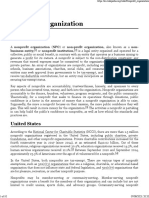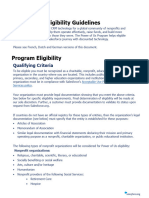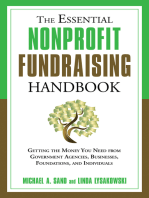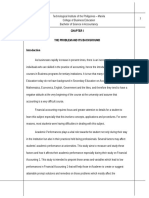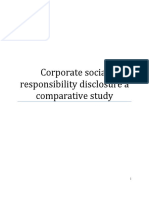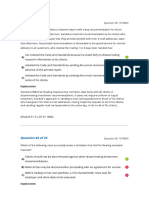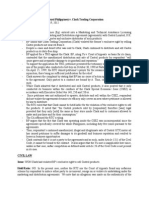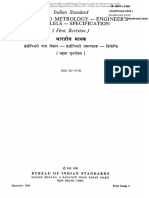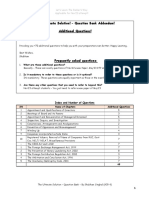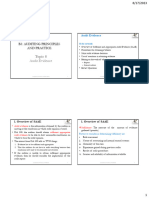VHWO
VHWO
Uploaded by
Jodie SagdullasCopyright:
Available Formats
VHWO
VHWO
Uploaded by
Jodie SagdullasOriginal Description:
Copyright
Available Formats
Share this document
Did you find this document useful?
Is this content inappropriate?
Copyright:
Available Formats
VHWO
VHWO
Uploaded by
Jodie SagdullasCopyright:
Available Formats
Technological Institute of the Philippine
363 P. Casal St., Quiapo, Manila
AC51FB1
ACCTG 533
WRITTEN REPORT
Voluntary Health and Welfare
Organization
Agda, Kat
Alfonso, Jomari C.
Alvarez, Dharlon James
Dela Torre, Mary Anne B.
Enriquez, Kenneth O.
Francisco, Sean Ace M.
Mastura, Mcoy Y.
Penoliar, Hazel E.
Sagdullas, Jodie M.
Technological Institute of the Philippine
363 P. Casal St., Quiapo, Manila
AC51FB1
ACCTG 533
What is a voluntary health and welfare organization?
Voluntary health and welfare organizations (VHWOs) are those not-forprofit organizations that derive their revenue primarily from voluntary
contributions from the general public to be used for general or specific
purposes connected with health, welfare, or community services. There are
two separate parts to this definition:
1. the organization must derive its revenue from voluntary
contributions from the general public (which does not include
governmental entities), and
2. the organization must be involved with health, welfare, or
community services.
Many organizations fit the second part of this definition, but receive a substantial
portion of their revenues from sources other than public contributions. For example,
an opera company would not be a VHWO even though it exists for the common
good, since its primary source of income would be box office receipts. Likewise, a
community organization like the YMCA would be excluded because it normally
receives most of its revenues from dues and program fees. On the other hand, a
museum would be excluded even if most of its revenue came from contributions,
since its activities are essentially educational and not focused on the areas of health
and welfare.
Some additional examples of VHWOs are the following:
a.
b.
c.
d.
e.
f.
Salvation Army;
Red Cross;
Goodwill (local chapters);
United Way, Boy Scouts;
Girl Scouts, Boys & Girls Clubs;
nonprofit organizations whose purpose is to find cures for diseases
or to assist people diagnosed with diseases such as cancer,
diabetes, heart disease or muscular dystrophy
FASB ASC 958 differentiates between voluntary health and welfare entities and
other nonprofit entities. For example, only VHWOs are required to present a
statement of functional expenses as a basic financial statement. Therefore, it is
important to how your organization should be defined to know if this requirement
applies to your financial statements. But, as noted above, sometimes the
distinction can be difficult to make. If you are unsure, it is recommended to include
a statement of functional expense as a basic financial statement.
There is additional guidance available in a book titled Standards of Accounting and
Financial Reporting for Voluntary Health and Welfare Organizations, Fourth Edition,
1998 (also known as the Black Book). The Black Books objective is to attain
Technological Institute of the Philippine
363 P. Casal St., Quiapo, Manila
AC51FB1
ACCTG 533
uniform accounting and external financial reporting in compliance with GAAP by all
voluntary health and welfare organizations. The Black Book does not establish
GAAP but rather explains existing authoritative literature and gives illustrations
relevant to VHWOs.
Technological Institute of the Philippine
363 P. Casal St., Quiapo, Manila
AC51FB1
ACCTG 533
The Black Book expands on the definition and notes that voluntary contributions
from the general public may include the following:
- Direct gifts from board members
- Private foundations
- Corporations
- Allocations of contributions that federated fund-raising organizations or
affiliated organizations receive from the general public
Finally, the Black Book states that an organizations membership in, or affiliation
with, the National Health Council, Inc., the National Human Services Assembly, or
the United Way of America is usually an indicator that the organization should be
identified as a VHWO.
Accounting for a VHWO
-
Similar to other not-for-profit organizations except for special
financial statements that report on the important aspects of VHWOs
The accrual basis of accounting is required
VHWOs have been free to use fund accounting in their accounting
and reporting processes
Financial statements for a VHWO:
Statement of financial position
Statement of activities
Statement of cash flows
Statement of functional expenses
The statements are designed primarily for those who are interested in the
organization as outsiders
Statement of financial position for a VHWO
Major balance sheet accounts are as follows:
i. Pledges from donors
ii. Investments
iii. Land, buildings, and equipment
iv. Liabilities
v. Net assets
Technological Institute of the Philippine
363 P. Casal St., Quiapo, Manila
AC51FB1
ACCTG 533
Statement of activities
The overall structure of the statement of activities for voluntary health and
welfare organizations and other not-for-profit entities should be very similar
as a result of FASB 117
Public support
i. The primary source of funds is likely to be contributions
from individuals or organizations that do not derive any
direct benefit from the VHWO for their gifts
Revenues
i. Funds received in exchange for services provided or
other activities
Gains
i. Gain or loss on sale of investments and other assets
Donated materials and services
i. Should be recorded at fair value when received
Expenses
i. Information about the major costs of providing services
to the public, fund-raising, and general and
administrative costs
Costs of informational materials that include a fund-raising
appeal
i. Many VHWOs prefer to classify such costs as program
rather than fund-raising
Statement of cash flows
The format of this statement is similar to that for hospitals
Statement of functional expenses
Details the items reported in the expenses section of the
statement of activities
Summary of Accounting and Financial Reporting for VHWOs
Reporting requirements are specified in FASB 116, FASB 117,
and the AICPA Audit and Accounting Guide for Not-for-Profit
Organizations
The accrual basis of accounting is used
Primary activities are reported in the unrestricted asset class
Technological Institute of the Philippine
363 P. Casal St., Quiapo, Manila
AC51FB1
ACCTG 533
Resources restricted by the donor for specific operating
purposes or future periods are reported as temporarily
restricted assets
Assets contributed by the donor with permanent restrictions
are reported as permanently restricted assets
You might also like
- Accounting For Non-Profit OrganizationsDocument39 pagesAccounting For Non-Profit Organizationsrevel_13193% (29)
- Suggested Answers To The 2022 Civil Law Bar Exam Questions Part 1Document16 pagesSuggested Answers To The 2022 Civil Law Bar Exam Questions Part 1marko.sanchez.2023No ratings yet
- Warehouse Safety ChecklistDocument3 pagesWarehouse Safety ChecklistMatthew Lee100% (1)
- Ohio Attorney General's Nonprofit HandbookDocument30 pagesOhio Attorney General's Nonprofit HandbookMike DeWine100% (3)
- Study Habits - Academic PerformersDocument71 pagesStudy Habits - Academic PerformersJodie Sagdullas85% (48)
- Nature and Scope of The New Government Accounting SystemDocument16 pagesNature and Scope of The New Government Accounting SystemkmNo ratings yet
- Determinants of Academic Performance in Taxation 1Document55 pagesDeterminants of Academic Performance in Taxation 1Jodie SagdullasNo ratings yet
- Increase Facebook GroupDocument37 pagesIncrease Facebook GroupTeodora IvanNo ratings yet
- Organization Social Cause Surplus Revenues DividendsDocument4 pagesOrganization Social Cause Surplus Revenues DividendsnicahNo ratings yet
- Organization Social Cause Surplus Revenues DividendsDocument4 pagesOrganization Social Cause Surplus Revenues DividendsnicahNo ratings yet
- Identify and Analyze IT System Components To Be MaintainedDocument12 pagesIdentify and Analyze IT System Components To Be MaintainedAbraha GebrekidanNo ratings yet
- Chapter X Accounting For Other Not For Profit Entities AutosavedDocument21 pagesChapter X Accounting For Other Not For Profit Entities Autosavednatnaelsleshi3No ratings yet
- How To Establish A Neighborhood Association: DraftDocument31 pagesHow To Establish A Neighborhood Association: DraftDuril WhiteNo ratings yet
- BADVAC3X NPO Discussion - de OcampoDocument6 pagesBADVAC3X NPO Discussion - de Ocamponaicamendoza16No ratings yet
- Chapter 16, Modern Advanced Accounting-Review Q & ExrDocument25 pagesChapter 16, Modern Advanced Accounting-Review Q & Exrrlg4814100% (4)
- 2D. NPO VHWO and OthersDocument6 pages2D. NPO VHWO and OthersJSNo ratings yet
- Subject: TopicDocument21 pagesSubject: TopicDharmikNo ratings yet
- Accounting For Government and Other Not-For-Profit EntitiesDocument24 pagesAccounting For Government and Other Not-For-Profit EntitiesThomasGetyeNo ratings yet
- Accounting For Government and Not-For-Profit OrganizationsDocument29 pagesAccounting For Government and Not-For-Profit OrganizationsPatricia ReyesNo ratings yet
- Npos vs. PoDocument4 pagesNpos vs. Pocindycanlas_07No ratings yet
- Module 1-Association Nonprofit BasicsDocument6 pagesModule 1-Association Nonprofit BasicstsafriendsNo ratings yet
- Nonprofit Organization Info.Document14 pagesNonprofit Organization Info.Chino PaciaNo ratings yet
- FundraisingDocument3 pagesFundraisingDEEPAK GROVERNo ratings yet
- Fundraising: 1 OrganizationsDocument6 pagesFundraising: 1 OrganizationsA.No ratings yet
- 01 GNFP Chapter OneDocument20 pages01 GNFP Chapter Onesabit hussenNo ratings yet
- Accounting For Government and Not-For-Profit OrganizationsDocument30 pagesAccounting For Government and Not-For-Profit OrganizationsPatricia ReyesNo ratings yet
- Ngo Industry: Presented By: Neha & SwatiDocument34 pagesNgo Industry: Presented By: Neha & SwatispinxxxxxNo ratings yet
- Nonprofit OrganizationDocument9 pagesNonprofit OrganizationMichelleNo ratings yet
- Ucsp Ngokngok GroupDocument15 pagesUcsp Ngokngok GroupAnshley EsmayaNo ratings yet
- Ngos1 2Document35 pagesNgos1 2hasan jabrNo ratings yet
- What Are The Advantages and Disadvantages For Nonprofit, Tax-Exempt Status?Document6 pagesWhat Are The Advantages and Disadvantages For Nonprofit, Tax-Exempt Status?nicahNo ratings yet
- Fundraising or Fund RaisingDocument6 pagesFundraising or Fund RaisingSumanta Bulan BoseNo ratings yet
- Non Profit AccountingDocument36 pagesNon Profit Accountingapi-3837252100% (3)
- Audit of Non Profit Organizations and HospitalsDocument9 pagesAudit of Non Profit Organizations and Hospitalsanondoggo1523No ratings yet
- From 04/07/2021 To 10/08/2021 Submitted byDocument24 pagesFrom 04/07/2021 To 10/08/2021 Submitted bydiksha singhNo ratings yet
- The Law of Tax-Exempt Healthcare Organizations 2016 SupplementFrom EverandThe Law of Tax-Exempt Healthcare Organizations 2016 SupplementNo ratings yet
- Overview of NGOs-NPOsDocument27 pagesOverview of NGOs-NPOsShieldon Vic Senajon PinoonNo ratings yet
- Thinking of Forming A Non ProfitDocument36 pagesThinking of Forming A Non ProfitManuel Fernando Nunez100% (5)
- Accounting For Government and Not-For-Profit OrganizationsDocument17 pagesAccounting For Government and Not-For-Profit OrganizationsAngela QuililanNo ratings yet
- Nonprofit VsDocument2 pagesNonprofit VsAnNo ratings yet
- MNPO AssignmentDocument4 pagesMNPO AssignmentAishwarya KhopkarNo ratings yet
- Four Types of Not-For-Profit / Service OrganizationsDocument22 pagesFour Types of Not-For-Profit / Service OrganizationsMargenete CasianoNo ratings yet
- Advanced Topics in Accounting ResearchDocument6 pagesAdvanced Topics in Accounting ResearchKashémNo ratings yet
- Chapter 1Document38 pagesChapter 1belay wubeNo ratings yet
- Nonprofit Guide 11 05 08Document4 pagesNonprofit Guide 11 05 08Ayode LongeNo ratings yet
- 4 My God This Is BsDocument10 pages4 My God This Is BscacapedopoulosNo ratings yet
- Deciding On The Donee: Step3Document4 pagesDeciding On The Donee: Step3FedsNo ratings yet
- Fund CH 1Document6 pagesFund CH 1meron fitsumNo ratings yet
- Role of Chartered Accountants in India'sDocument25 pagesRole of Chartered Accountants in India'sprateekchaudhary09No ratings yet
- Notes On Restricting Non-Profit InvestingDocument2 pagesNotes On Restricting Non-Profit InvestingCourtney SullivanNo ratings yet
- Accounting For Non-Profit OrganizationsDocument40 pagesAccounting For Non-Profit Organizationsrevel_131100% (7)
- Advanced Financial AccountingDocument8 pagesAdvanced Financial AccountingEKI TEENENo ratings yet
- Instructional Materials For NPODocument17 pagesInstructional Materials For NPOChristen HerceNo ratings yet
- Question #1: (AICPA.110589FAR)Document5 pagesQuestion #1: (AICPA.110589FAR)iceman2167No ratings yet
- Frequently Asked Questions On PCNCDocument3 pagesFrequently Asked Questions On PCNCbobbysingersyahooNo ratings yet
- Instructional Materials For NPODocument16 pagesInstructional Materials For NPOwoahae13No ratings yet
- Chapter 21 BMWDocument22 pagesChapter 21 BMWSincero MilanNo ratings yet
- An Introduction To The Voluntary SectorDocument4 pagesAn Introduction To The Voluntary SectorMoybul AliNo ratings yet
- Defination and MeaningDocument5 pagesDefination and MeaningMehwish ButtNo ratings yet
- SALESFORCEDocument12 pagesSALESFORCEDaniel VillaverdeNo ratings yet
- Unit 9: Nonprofit OrganizationsDocument2 pagesUnit 9: Nonprofit OrganizationsfujionoNo ratings yet
- Nonprofit HandbookDocument32 pagesNonprofit HandbookMike DeWine100% (5)
- Chapter One Overview of Governmental and Not For Profit Organizations 1.0. Learning ObjectivesDocument24 pagesChapter One Overview of Governmental and Not For Profit Organizations 1.0. Learning ObjectivesshimelisNo ratings yet
- Presentation On Non-Profit OrganisationDocument11 pagesPresentation On Non-Profit OrganisationAnand Kumar Mishra100% (1)
- Get Approved: Grant Writing Secrets Most Grant Givers Do Not Want You To Know – Even In a Bad EconomyFrom EverandGet Approved: Grant Writing Secrets Most Grant Givers Do Not Want You To Know – Even In a Bad EconomyRating: 5 out of 5 stars5/5 (3)
- The Essential Nonprofit Fundraising Handbook: Getting the Money You Need from Government Agencies, Businesses, Foundations, and IndividualsFrom EverandThe Essential Nonprofit Fundraising Handbook: Getting the Money You Need from Government Agencies, Businesses, Foundations, and IndividualsNo ratings yet
- Miscellaneous Transaction QuizDocument2 pagesMiscellaneous Transaction QuizJodie SagdullasNo ratings yet
- Factors Influencing Academic Performance in Management AccountingDocument51 pagesFactors Influencing Academic Performance in Management AccountingJodie Sagdullas81% (16)
- Study Habits of Bsa Students at Tip-ManilaDocument44 pagesStudy Habits of Bsa Students at Tip-ManilaJodie Sagdullas88% (56)
- Attrition of BSADocument46 pagesAttrition of BSAJodie Sagdullas100% (4)
- Students' Perception of The Causes of Low Performance in Financial AccountingDocument48 pagesStudents' Perception of The Causes of Low Performance in Financial AccountingJodie Sagdullas100% (2)
- Personal-Budgeting Research ProperDocument46 pagesPersonal-Budgeting Research ProperJodie Sagdullas85% (110)
- Cisco Case StudyDocument7 pagesCisco Case StudyEsperanza DíazNo ratings yet
- Corporate Social Responsibility at BP Plc. Dissertation ProposalDocument24 pagesCorporate Social Responsibility at BP Plc. Dissertation Proposalshams78600No ratings yet
- 7 DBG 314 Weekly Progress Report-3Document17 pages7 DBG 314 Weekly Progress Report-3NisaNo ratings yet
- Reading 91.4 Guidance For Standards III (A) and III (B) - AnswersDocument13 pagesReading 91.4 Guidance For Standards III (A) and III (B) - AnswersTNHNo ratings yet
- Final MockDocument5 pagesFinal MockAbdullahSaqibNo ratings yet
- BP Philippines v. Clark Trading CorporationDocument2 pagesBP Philippines v. Clark Trading CorporationRaymond Cheng100% (1)
- Graduation IIT Bombay IIT Bombay 2024 7.69: (June'23 - July'23)Document1 pageGraduation IIT Bombay IIT Bombay 2024 7.69: (June'23 - July'23)Sanket AmbreNo ratings yet
- DIFINITION OF ACCOUNTING (Reviewer) 22Document8 pagesDIFINITION OF ACCOUNTING (Reviewer) 22Shira MaghanoyNo ratings yet
- Canvasser Resume HelpDocument8 pagesCanvasser Resume Helpfrebulnfg100% (2)
- 100ppt PDFDocument147 pages100ppt PDFHo Ming Lam100% (1)
- Union Bank Indemnity BondDocument1 pageUnion Bank Indemnity BondagmediasinfoNo ratings yet
- ADV Global UP PlasticDocument2 pagesADV Global UP PlasticAsufteNo ratings yet
- E-Business Comparison Local and InternationalDocument10 pagesE-Business Comparison Local and InternationalFarheen MunsoorNo ratings yet
- Spring 2021 5.1 - Change Orders and Change Order Processes: Students To ReadDocument4 pagesSpring 2021 5.1 - Change Orders and Change Order Processes: Students To ReadAditya TawareNo ratings yet
- Kit MantencionDocument6 pagesKit MantencionChristianM.Carrasco100% (1)
- MBA Thesis Title Meiktila 11th Batch 2016Document5 pagesMBA Thesis Title Meiktila 11th Batch 2016Tha Toe100% (2)
- 1224 2616 1 PBDocument20 pages1224 2616 1 PBDasmi PutraNo ratings yet
- Curriculum VitaeDocument3 pagesCurriculum VitaeAnonymous ZzCE3tlNo ratings yet
- Is 4241-1990 (R.a. 2020)Document6 pagesIs 4241-1990 (R.a. 2020)HARIOM INSTRU-LABSNo ratings yet
- MA NotesDocument47 pagesMA NotesPeiyi TayNo ratings yet
- CA Final Addendum Sheet - Nov'23Document58 pagesCA Final Addendum Sheet - Nov'23Utkarsh GuptaNo ratings yet
- Cleaning Solution - Touch N VanishDocument16 pagesCleaning Solution - Touch N VanishPayal MukherjeeNo ratings yet
- Business TaxDocument116 pagesBusiness TaxScarlett FernandezNo ratings yet
- Traducción y Opinion Del Articulo en Ingles - LaboralDocument2 pagesTraducción y Opinion Del Articulo en Ingles - Laborallaura mendozaNo ratings yet
- B3 - Audit EvidenceDocument8 pagesB3 - Audit EvidenceFrank AlexanderNo ratings yet
- Time Value of MoneyDocument9 pagesTime Value of Moneykedir MekonnenNo ratings yet
- Introduction - Conclusion Có HighlightDocument6 pagesIntroduction - Conclusion Có HighlightHanNo ratings yet













































